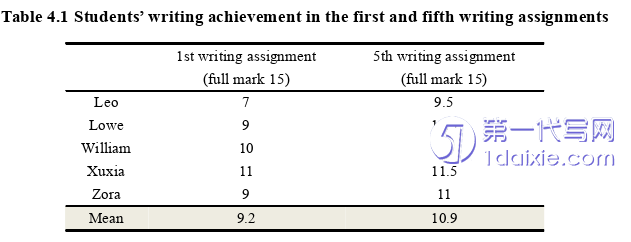本文是一篇英语论文,笔者认为在使用混合型反馈时,教师还应考虑学生的个体差异。向学生介绍多样的可观测性策略和元认知操作等,让学生能够使用适合自己的方式,有针对性加强对混合型反馈的投入,进而提高写作成绩。
Chapter 1 Introduction
1.1 Research Background
An important way of learning is engaging in feedback.Recognizing feedback iscrucial in second language(L2)writing,Chinese teachers tend to keep an eye onstudents’academic performance by giving feedback.But most of them pay littleattention to student engagement with feedback,leaving students in a passive state oflearning.After giving feedback,most high school teachers rarely require students torewrite or revise their essays.This leads some students to put their essays aside withjust a glance at the score and ignore the feedback and comments that are essential fortheir development(Ferris,1995).In the end,these teachers find that their feedbackdoes not help improve students’writing effectively because student engagement,being neglected,is a crucial link between feedback and learning outcomes(Ellis,2010)and an important potential factor in enhancing students’learning(Zhang&Hyland,2018).
In recent years,interest in how students engage with feedback has grown,particularly in higher education.Scholars at home and abroad have realized thecrucial role of student engagement with feedback in language learning and sought toestablish its conceptual framework(Han&Hyland,2015;Mao&Lee,2022).Additionally,other scholars have conducted research on how students engage withteacher written corrective feedback(Zheng&Yu,2018),automated writingevaluation(Xu&Han,2020),and peer feedback(Fan&Xu,2020)to identifyinfluential factors,such as learner belief(Han,2017).However,few practicalapproaches that could help facilitate student engagement with feedback have beenexplored by previous research.
1.2 Purposes and Significance of the Research

This study has several purposes.Firstly,its purpose is to confirm the effect ofmixed feedback on students’writing achievement.Secondly,it intends to examine theimpact of mixed feedback on student engagement by comparing changes in studentengagement with feedback before and after implementing mixed feedback.Besides,italso aims to comprehensively understand and describe how students engage withmixed feedback by recording diachronic changes within the experiment.Based on thepurposes above,the study attempts to address the following questions:
1)Can mixed feedback promote high school students’English writingachievement?
2)Can mixed feedback promote high school students’engagement withfeedback?
3)What diachronic changes might happen in students’engagement with mixedfeedback?
Chapter 2 Literature Review
2.1 Core Concepts
To provide a clear structure for the present study,it is necessary to clarify thecore concepts of the research.There are three core concepts to be defined andintroduced in the following session,which are feedback,mixed feedback,and studentengagement.
2.1.1 Feedback and Mixed Feedback
Feedback is defined differently in different fields.In the field of L2 writing,Keh(1990)regards feedback as the drive steering a writer through the process of writingon to the product in the writing process.He believes that feedback is input to a writerfrom his readers for the purpose of providing information to this writer to revise hisarticles,such as comments,questions,and suggestions.Ellis(1994)gives a generaldefinition of“feedback”in second language acquisition(SLA).He holds thatfeedback is a kind of error treatment,which is the information received from listenerswhen they read and comprehend messages.In the field of language teaching andapplied linguistics,the word“feedback”is introduced and defined by Richard andSchmidt(2013)as comments or other information that learners receive from teachersor other people about their performance on learning tasks or tests.
2.2 Multi-dimensional Theoretical Framework of StudentEngagement
The definition of student engagement has been discussed in the previous part.Inthis part,multi-dimensional theoretical frameworks of student engagement andstudent engagement with feedback will be introduced.Student engagement hasemerged as an essential subject in L2 studies due to its significant role in therelationship between feedback and learning outcomes(Ellis,2010)and its potential toimprove students’learning(Zhang&Hyland,2018).More and more scholars haveheld in mind that student engagement should be considered and measured fromdiverse aspects to help quantify student engagement more comprehensively.Thesemulti-dimensional theoretical frameworks enrich the connotation of studentengagement and try to give a detailed and in-depth description of student engagementfrom different perspectives.
About two decades ago,Finn(1989)proposed the participation-identificationmodel,focusing on students’involvement in school to better explain the problem of school dropout.In his model,student engagement consists of two parts:participationand identification.Participation is the external and behavioral component,whichcovers students’attention to the teacher,reading,study,memorization,response toquestions,completion of assignments,and so on.At the same time,identification isthe internal and emotional component,which includes belongs and valuing.Finn’smodel has inspired further study on student engagement,leading scholars to take amulti-dimensional approach to the topic.However,as students may not processlearning content deeply,but they are observed to be engaged in tasks,studentengagement may be more complex than these two dimensions(Appleton et al.,2006).
Chapter 3 Methodology..........................24
3.1 Research Questions...............................24
3.2 Research Method..............................25
Chapter 4 Results and Discussion.....................................34
4.1 Impact of Mixed Feedback on Students’Writing Achievement...................34
4.2 Impact of Mixed Feedback on Student Engagement with Feedback and itsDiachronic Changes while Using Mixed Feedback..............................................37
Chapter 5 Conclusion.....................................61
5.1 Major Findings............................................61
5.2 Implications of the Study...................61
Chapter 4 Results and Discussion
4.1 Impact of Mixed Feedback on Students’Writing Achievement
The impact of mixed written feedback on students’writing achievement wasanalyzed by comparing the scores of five students in the first and fifth writingassignments,as well as the scores for each part of these assignments.The results arepresented in Table 4.1 and Table 4.2.

As shown in Table 4.1,there is an obvious difference in students’writingachievement after the experiment.The mean score for the fifth writing assignment is10.9,while it is 9.2 in the first writing assignment,indicating that students’averagewriting score in the fifth assignment is 1.7 points higher than that in the first one.Thisresult demonstrates that mixed feedback does improve students’overall writing achievement.
Chapter 5 Conclusion
5.1 Major Findings
While previous experiments have confirmed the effectiveness of mixed feedbackin L2 writing,most studies investigate a discrete aspect and focus less on students’central role in learning.This study aims to address this gap by implementing fiveconsecutive sessions of mixed feedback from a student-centered perspective.Whileanalyzing its impact on five participants’writing achievement,this paper provides acomprehensive and detailed description of how mixed feedback influences studentengagement with feedback before and after the experiment.It also records diachronicchanges in student engagement while using mixed feedback.These findings mayfurther validate the effectiveness of mixed feedback and help establish a more robustframework for student engagement with feedback in future research.Based on datafrom multiple sources obtained from five senior high school students,this study drawsthe following conclusions.
The first question is to figure out the effectiveness of mixed feedback on students’writing achievement.This study revealed that the utilization of mixed feedbackyielded a positive impact on fostering English writing achievement among students.The scores obtained for four subparts,i.e.,content,language,organization,as well ashandwriting,indicated that students primarily exhibited improvement in their contentand language within their compositions.However,discernible progress was notobserved pertaining to organization or handwriting.
reference(omitted)
